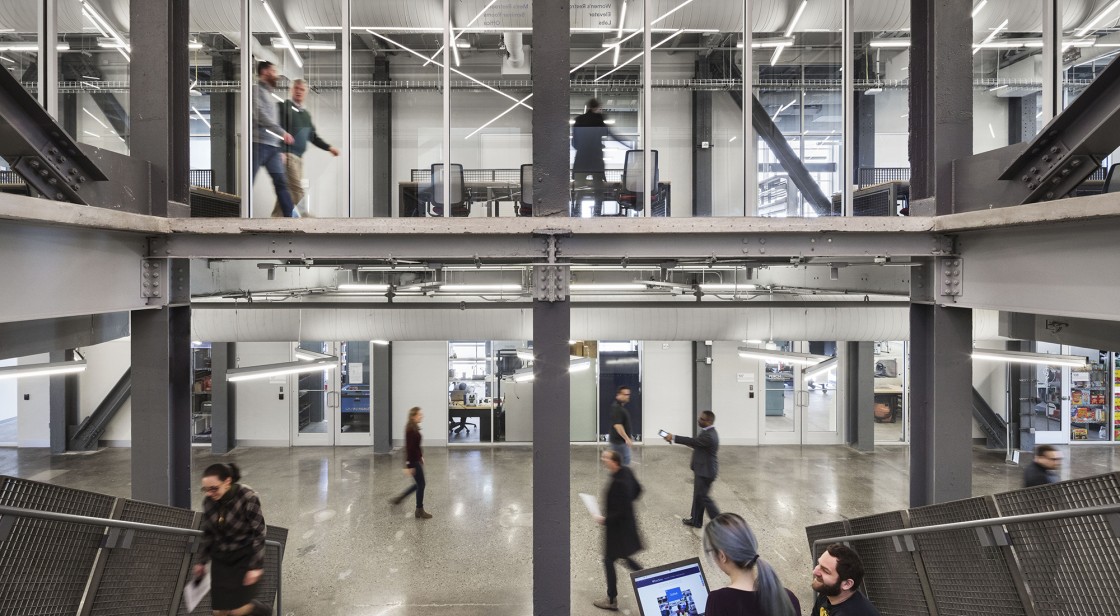Institutional resilience has never been more critical. To explore this important topic, KSS facilitated a discussion with representatives from the University of Pennsylvania, a leader in planning and designing for long-term resilience, at the Society for College and University Planning’s Mid-Atlantic Conference. KSS Partner Mayva Donnon, moderated the dialogue, joined by Karl Ulrich, Vice Dean of Entrepreneurship & Innovation at the Wharton School of the University of Pennsylvania; Leandra Davis, Senior Director of Planning, Design, & Construction at Penn Engineering; Mark Kocent, University Architect at the University of Pennsylvania; and KSS Partner and higher education expert Petar Mattioni.
The session, titled “Institutional Resilience: Cross-Disciplinary Innovation, Entrepreneurship, & Change Management” explored delivery methods, change management strategies, university commitment to entrepreneurship and applied research, and multi-modal learning through the lens of two Penn projects: Pennovation Center and Tangen Hall. Pennovation Center, a blend of labs, offices, and production space, is a dynamic environment where inventiveness is translated into viable ventures. Tangen Hall, a hub for all student-based entrepreneurial activities at Penn, acts as a “start here” button for students on campus and a beacon to the outside world of Penn’s commitment to innovation, entrepreneurship, and research.
Value Add in Diverse Delivery Methods
Due to their location outside of Penn’s campus core, both Pennovation and Tangen Hall projects utilized less conventional delivery methods, each with its own benefits to the University. For Pennovation, the University acted as the developer as it typically does, with one difference; the Facilities and Real Estate Services group acted as Construction Manager, rather than the Planning, Design, & Construction group. This approach, University Architect Mark Kocent explained, allowed the University to be nimbler. For Tangen Hall, utilizing a third-party developer turn key method has resulted in a significantly accelerated project schedule and decreased project cost.
Cross-Disciplinary Collaboration Requires Personal Relationships Among Faculty + Spatial Variety
Bringing different programs together in the same building for cross disciplinary collaboration affords exciting opportunities, but also presents practical challenges. One such challenge is integration among faculty and staff from various disciplines. As Wharton Vice Dean of Entrepreneurship & Innovation Karl Ulrich notes, “integration is not a student problem, but a faculty and staff problem.” Whereas students integrate across departments and schools with ease, faculty and staff often struggle to adopt a shared vision. Ulrich emphasizes the importance of cultivating personal relationships among faculty to smooth the integration.
At Pennovation, when five groups across the School of Engineering and Applied Sciences were moved into one open space, acoustics quickly became an issue. As Leandra Davis, Senior Director of Planning, Design, & Construction at Penn Engineering, noted, “the space was being used for activities from coding, to banging robots together, to drones flying in the middle of the space.” From this challenge it became clear that while cross-disciplinary innovation often translates to open or transparent environments, it can also look like quiet, private space. Penn adapted, leasing nearby space they refer to as “the library” to provide a quieter atmosphere for focused work.
Agents of Change Management
Leandra Davis, who recently received a master’s at Penn in Leading and Managing Through Change, underscores the importance of understanding that change and innovation is a process, not a singular event. In this process, it is crucial to have buy in and involvement from senior leadership, who should model the behavior they want to see. Of course, people impacted by the change need to be involved throughout the entire process, with engagement starting at the beginning of the project to instill a sense of ownership. Leandra identified middle management as a key participant group in facilitating change management, saying “when middle management is supported, engaged, trained, and empowered, they can be very influential and become your key agents of change. If middle management does not have that level of support and trust, they can become the “frozen middle” and prohibit productive change.” This group across the institution can really influence culture change. With empowered middle managers, you can begin to set expectations, but keep in mind, they need to feel they have the authority to make decisions to support the change.
Blended Engagement Supported by Density, Diversity, + Choice
The current moment of COVID-related disruption has sparked myriad speculations as to the long-term impact to academics. KSS Partner Petar Mattioni sees “blended engagement”—a hybrid of in-person and virtual engagement—as a long-term change. How can we design for blended engagement, particularly in spaces meant to encourage collaboration and innovation? Petar’s take: “When it comes to blended engagement, choice is key. Students want to be able to choose where in the building they go or how they will join a class meeting. By providing highly diverse and dense space, our hope is that it will spark engagement and collaboration in ways we can’t even predict.”
As we pass the one-year mark of the pandemic, institutional resilience continues to be critical for universities and colleges to survive and thrive moving forward. For us as designers, we are passionate about design that supports institutional resilience, and look forward to continuing conversations around this topic as it evolves.

